
Mambas are fast moving venomous snakes of the genus Dendroaspis in the family Elapidae. Four extant species are recognised currently; three of those four species are essentially arboreal and green in colour, whereas the so-called black mamba, Dendroaspis polylepis, is largely terrestrial and generally brown or grey in colour. All are native to various regions in sub-Saharan Africa and all are feared throughout their ranges, especially the black mamba. In Africa there are many legends and stories about mambas.
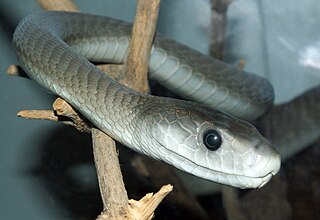
The black mamba is a species of highly venomous snake belonging to the family Elapidae. It is native to parts of sub-Saharan Africa. First formally described by Albert Günther in 1864, it is the second-longest venomous snake after the king cobra; mature specimens generally exceed 2 m and commonly grow to 3 m. Specimens of 4.3 to 4.5 m have been reported. Its skin colour varies from grey to dark brown. Juvenile black mambas tend to be paler than adults and darken with age.

The giant conebill is a small passerine bird, one of the tanager family. It is closely related to the regular conebills Conirostrum though it differs in its larger size and nuthatch-like foraging habits.

The royal cinclodes is a passerine bird which breeds in the Andes of south-east Peru and adjacent Bolivia. It was formerly considered to be a subspecies of the stout-billed cinclodes C. excelsior. It is 20 cm long and weighs 50 g with a heavy bill and dark chocolate-brown on the body, face and crown with whitish mottling and streaking on the breast.
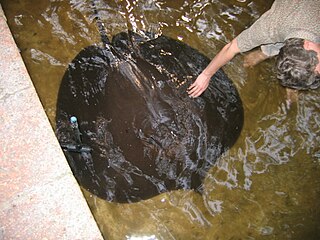
The giant freshwater stingray is a species of stingray in the family Dasyatidae. It is found in large rivers and estuaries in Southeast Asia and Borneo, though historically it may have been more widely distributed in South and Southeast Asia. One of the largest freshwater fish in the world, this species grows upwards of 1.9 m (6.2 ft) across and may reach 600 kg (1,300 lb) in weight. It has a relatively thin, oval pectoral fin disc that is widest anteriorly, and a sharply pointed snout with a protruding tip. Its tail is thin and whip-like, and lacks fin folds. This species is uniformly grayish brown above and white below; the underside of the pectoral and pelvic fins bear distinctive wide, dark bands on their posterior margins.

Polylepis is a genus comprising 28 recognised shrub and tree species, that are endemic to the mid- and high-elevation regions of the tropical Andes. This group is unique in the rose family in that it is predominantly wind-pollinated. They are usually gnarled in shape, but in certain areas some trees are 15–20 m tall and have 2 m-thick trunks. The foliage is evergreen, with dense small leaves, and often having large amounts of dead twigs hanging down from the underside of the canopy. The name Polylepis is, in fact, derived from the Greek words poly (many) plus letis (layers), referring to the shredding, multi-layered bark that is common to all species of the genus. The bark is thick and rough and densely layered for protection against low temperatures. Some species of Polylepis form woodlands growing well above normal tree line within grass and scrub associations at elevations over 5000 m; which makes Polylepis appear to be the highest naturally occurring arboraceous angiosperm genus in the world.

Polylepis australis, also known locally as tabaquillo or queñoa is a tree endemic of central Argentina, member of the family Rosaceae. The genus Polylepis originated in the eastern South America, Andean forests. The plant has small, pinnate leaves, 7–10 cm long, normally composed of five or seven leaflets. In harsh winters, Polylepis australis survives by producing rolls of loose, papery like exfoliating brownish bark; the rough outer covering of the woody stem of tree. The southernmost stands of Polylepis australis are located in the high Córdoba mountains of central Argentina.
Anabarilius polylepis is a species of ray-finned fish in the family Cyprinidae, that is endemic to Yunnan, China. It only occurs in Dian Lake and Songhuaba reservoir in Kunming. It was once a major commercial fish species, but it has not been confirmed in the lake since the 1970s. Its decline is attributed to many factors: introduced fish species, decreasing water quality, the loss of macrophytes, over-fishing, and the loss of breeding sites due to siltation and blocked access.

The Iberian nase is a species of freshwater fish in the family Cyprinidae. It is found in Portugal and in Spain. Its natural habitats are rivers and intermittent rivers.
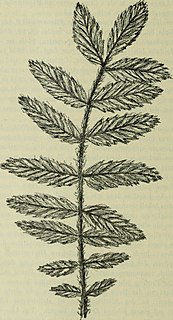
Polylepis multijuga is a species of plant in the family Rosaceae. It is endemic to montane forests in the Peruvian Northern Andes, between 2700 and 3600 meters above sea level. It is threatened by habitat loss.
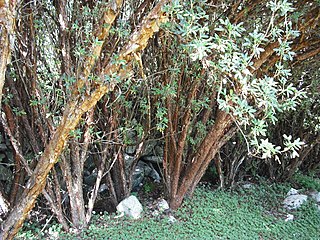
Polylepis racemosa is a species of small tree in the family Rosaceae. It is endemic to Peru, Bolivia, and Ecuador. It is threatened by habitat destruction. The International Union for Conservation of Nature has assessed the conservation status of this tree as "vulnerable".

Polylepis rugulosa, the queñua, is a species of plant in the family Rosaceae. It is primarily found in the Andes region of South America in Argentina, Bolivia, Chile and Peru. It is currently threatened by habitat loss.
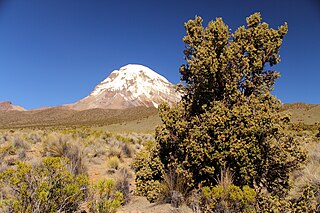
Polylepis tomentella, known in its native habitat by the Spanish common name queñoa de altura, is a short tree or shrub which is found in small, scattered groupings along the mountainous borders of Bolivia, Chile, and Peru, growing in soil formed by volcanoes. Populations may also be present in Argentina, but this is unconfirmed.

Balistes is a genus of triggerfish.

The pyramid butterflyfish is a species of marine ray-finned fish, a butterflyfish belonging to the family Chaetodontidae, native from central Indo-Pacific.
The smallscale yellowfish is a South African species of freshwater fish in the cyprinid family. It is native to the Limpopo, Incomati and Pongolo drainages.

Vanilla polylepis is a climbing orchid species in the plant family Orchidaceae. It is native to tropical Africa, with a range spanning the width of the continent, from Kenya to Angola. It grows in high-altitude evergreen and swamp forests between 1,200–1,500 m (3,900–4,900 ft) and is often found growing on trees bordering rivers and waterfalls. Plants produce bright green, fleshy stems, 10–12 mm (0.39–0.47 in) in diameter, with large, glossy leaves. White, aerial roots form on the stems allowing the orchids to attach themselves to trees for support. As with many orchids, they produce showy flowers, which in the case of V. polylepis are white and yellow with a pink to maroon blotch. This differentiates them from similar species. They have seedpod-like fruits, called capsules, which produce a distinctive aroma as they dry. They are closely related to the well-known species Vanilla planifolia, whose seed pods are used commercially in the production of vanilla flavouring.
Asana River is a waterway in the Moquegua Region of southern Peru. It is one of the tributaries of the Osmore River. The Asana archaeological site, occupied over the course of 8,000 years, is situated in a basin on the river's north bank. The Quellaveco mining project sought to divert the Asana for extractive waste material placement in its copper mining operations.

Bidens polylepis is a North American species of flowering plant in the daisy family. It is native to south-central Canada (Ontario) and to the eastern and central United States.

Balistes polylepis or Finescale triggerfish is a species of Balistes found in the Pacific Coast from San Francisco down to Callao, Peru and the Galapagos.

















